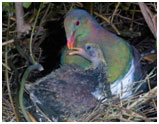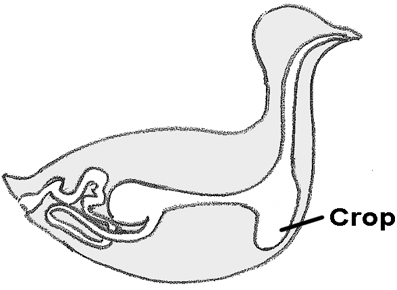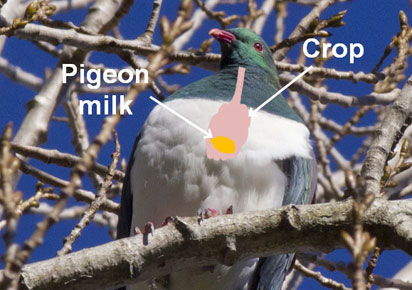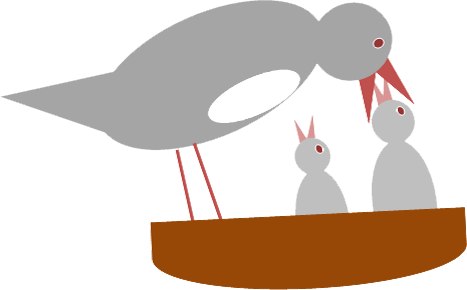Pigeon milk
0
Overview
Using this Resource
Connecting to the Curriculum
Marking Student Responses
Working with Students
Further Resources
This task is about how images can provide information that helps the reader to understand written text. The article is about kererū.
Task administration:
This task can be completed with pencil and paper or online (with SOME auto marking).
The task provides opportunities for co-operative knowledge building. For example students can
-
share and build on their responses to the observation inference question
-
discuss how people respond differently to elements of text, both written and visual.
Copyright:

Image: (c) Nga Manu Images.
Level:
5
Curriculum info:
Keywords:
Description of task:
Task: Choose images to enhance a science text about an adaptation of kererū, compare the messages of images, and reflect on the role of illustrations in science texts. Assessment focus: using and interpreting images in science texts.
Curriculum Links:
Science capabilities
The capabilities focus is brought about by the conversations you have and the questions you ask.
Capability: Gather and interpret data
This resource provides opportunities to discuss the clues that the pictures provide to help us make inferences.
Capability: Interpret representations
This resource provides opportunities to discuss the challenges of integrating written and visual texts
Science capabilities:
Answers/responses:
| Question | What to look for | Examples of student responses | |
| Match images to text. |
   |
||
|
Which illustration could be used to provide the best evidence that kererū chicks grow quickly?
|
A line graph showing weekly weight gains of a kererū chick. | ||
| What does the first diagram show that the second doesn't? |
References to:
|
Where the pigeon milk comes from.
It labels the milk.
What the bird actually looks like.
|
|
| Which things can you really see, and which were things the photograph made you think might be true? |
Observations
Anything that can be seen, e.g, colours, comparative size.
Inferences
Anything that the photograph suggests to the reader, including reference to the written text
(Do not accept "one bird has its beak open" or "the parent bird is feeding its chick" - provided as an example.)
|
Observations
They have green and white feathers.
Both their beaks are pointing to each other.
There are two birds.
Inferences
They are in a tree or undergrowth.
It is still a baby and will only get the green feathers when it grows up.
It's feeding it milk.
Those birds love each other.
The chick was born not that long ago before this photo was taken.
The baby is hungry for food.
|
|
| Select one advantage | Accept any answer | ||
| Write a paragraph explaining why the example you chose is an advantage for kererū. |
Describes how the advantage selected supports the survival of the species, i.e. how it is an advantage.
Here are more specific aspects to look for relative to the different choices.
The chicks grow quickly.
Chicks don't have to spend a long time in the nest.
Reference to being in a nest increases vulnerability to predators, quick growth equates to less time in the nest.
The chicks are not fed on insects
Reference to parent birds not having to rely on finding food, baby birds don't have to rely on insects being available. This means they are less vulnerable to poor food supply.
Pigeon milk is rich in protein.
Reference to a ready source of protein makes the baby birds less vulnerable to poor food supply, ensures they grow quickly so they spend less time vulnerable to predation. Because kererū are big birds, the chicks need to grow a lot, so fast growth is even more important.
Both parents can feed milk to the chicks.
Reference to less vulnerability to losing a parent.
Note: Although students were asked to write a paragraph, we marked this question on their ideas rather than the structure of the answer.
|
If the baby pigeon grows quickly it can leave the nest quickly, which means it is not vulnerable for long.
Because the chicks are not fed on insects, the parents won't have to go out of their way to find insects. Not much effort would be put in if they just gave the chick pigeon milk.
They're not always in one place, making it less likely for them to be eaten by predators.
If one parent dies the chick can still survive. The mother can go away and find food and the father would still be able to provide food.
|
|
| Which image was best for helping you understand the writing about kererū? | Accept any answer. | ||
| Explain why. | Reference to the particular purpose for including the image/ what it highlights |
They show where the milk grows and how it is stored.
Shows exactly where the crop is inside the bird.
This diagram helps me see where the mentioned function is.
None of the pictures showed how fast the kereru grow and were not explained properly.
Having an actual picture of an adult kererū with the proper proportions makes it easier to understand where the milk is stored and how it could be plausible for them to produce milk.
|
|
Results based on an online sample of 44 Y10 students.
Diagnostic and formative information:
The use of images to support written text
- While the majority of students were able to select the correct image to support a piece of written text, it was much harder for them to describe how images do this.
- One student's response in particular showed the misconception that an image should show the "whole story": None of the images explains completely what the text was saying.
Next steps
Focus on developing the understanding that images are generally included to clarify a particular idea or concept. In doing so, the images emphasise the target idea, and other aspects are either minimised or omitted.
Ask students:
- What does the image show?
- What does it not show?
- What main idea is the focus for the image?
For the second question, where students were asked about two diagrams, look at the diagrams again within the text. Ask them to think about the main "message" that each image is used for. What features help it promote this message?
Encourage students, when they are writing their own texts, to carefully consider when and how an image might enhance their message.
- For this piece of text, what sort of image would best illustrate the idea?
For other ideas for activities about the role of diagrams in written science texts go to Interpret representations.
Observation and inference
The purpose of this question is to explore the fact that we infer meaning from images, just as we do from written text.
- Students gave a mix of observations and inferences.
- They were more likely to provide inferences (about 70% of all responses) than observations.
- Most students provided between one and three points.
- They were more likely to incorrectly classify inferences as observations than the other way round (observations as inferences). Examples of inferences that were classified as observations include: It's feathers are still growing; The mother is looking after her child; They are both in a nest in a forest;
Next steps
- Give students the opportunity to talk about whether what they can tell from an image is an observation or inference. Get them to question whether it can actually be seen, or is it what the image suggests to them.
- Sometimes it is difficult to decide. Discuss the part that knowledge plays in inferring from images. We can think about a continuum between observations and inferences, with sometimes a grey area in the middle. For example, is stating the kererū is a bird an observation (because we have sufficient deep knowledge to know this), or are we inferring it's a bird (because of the knowledge we bring to our interpretation)?
- Ask students to suggest why in science it might be important to know the difference between observation and inference. (Both are important skills, but they have different purposes. For more information go to Gather and interpret data.)
- For other activities go to the science capabilities website: The noisy reef - Watch this space - Food webs
Explaining advantages of an adaptation
The purpose of this task is to assess how well students understand the text (both written and visual). It is intended to model to students that visual text and written text work together to convey science information.
- Most trial students could talk about the advantage in general terms, but did not explain why that benefits kererū. The following are examples of incomplete responses:
The protein will allow for the young kererū to get all the nutrients they need to grow.
The pigeon milk helps the chick to grow by giving it lots of protein. This allows it to grow much faster.
The father can be hunting while the mother is feeding.
- Some students did not process information provided, just repeating what had aleady been given to them.
The pigeon milk is rich in protein which helps the chick grow quickly.
- Trial students were most likely to choose to explain the advantage Pigeon milk is rich in protein. This may have been because this information was very visible in the text. However, none of those who made this choice was able to give a good explanation for why this was an advantage.
- Trial students who explained the advantage Both parents can feed milk to the chicks were most likely to give a good explanation. (Note that the numbers of students who gave a good explanation was small - with a bigger sample this could change.)
Next steps
- If students give a partial answer, ask them to explain how this contributes to a) survival of the bird, and b) survival of the species.
Find other resources that address the science capability Interpret representations.
The following Level 4 and 5 ARB resources also are about interpreting diagrams:

